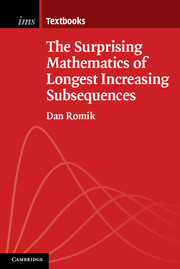Book contents
- Frontmatter
- Contents
- Preface
- 0 A few things you need to know
- 1 Longest increasing subsequences in random permutations
- 2 The Baik–Deift–Johansson theorem
- 3 Erdős–Szekeres permutations and square Young tableaux
- 4 The corner growth process: limit shapes
- 5 The corner growth process: distributional results
- Appendix Kingman's subadditive ergodic theorem
- Notes
- References
- Index
- References
References
Published online by Cambridge University Press: 05 October 2014
- Frontmatter
- Contents
- Preface
- 0 A few things you need to know
- 1 Longest increasing subsequences in random permutations
- 2 The Baik–Deift–Johansson theorem
- 3 Erdős–Szekeres permutations and square Young tableaux
- 4 The corner growth process: limit shapes
- 5 The corner growth process: distributional results
- Appendix Kingman's subadditive ergodic theorem
- Notes
- References
- Index
- References
Summary

- Type
- Chapter
- Information
- The Surprising Mathematics of Longest Increasing Subsequences , pp. 340 - 347Publisher: Cambridge University PressPrint publication year: 2015

